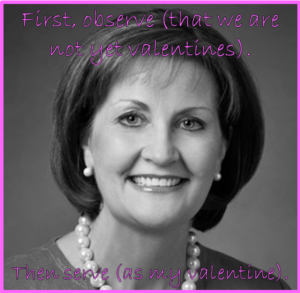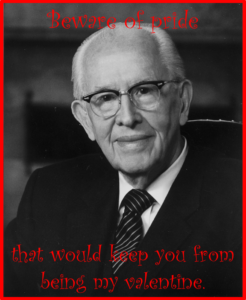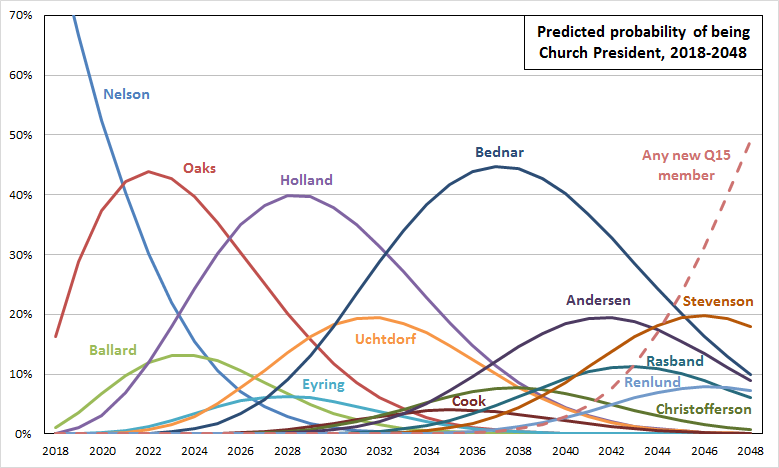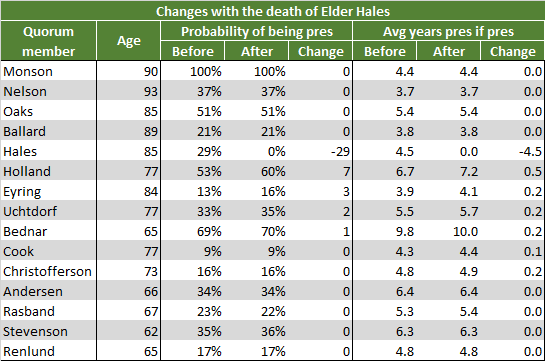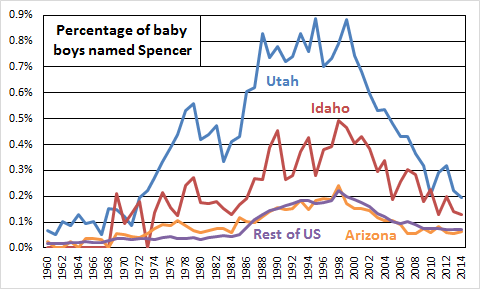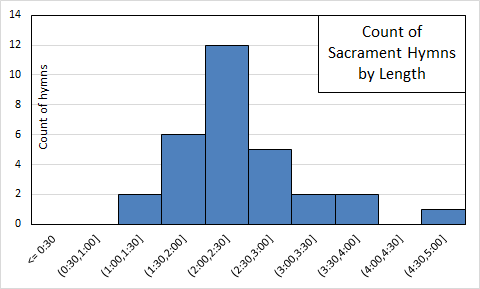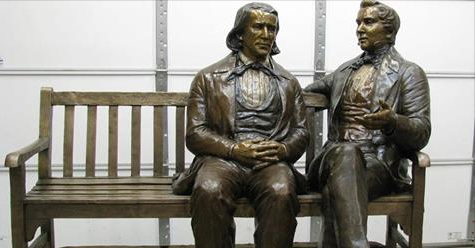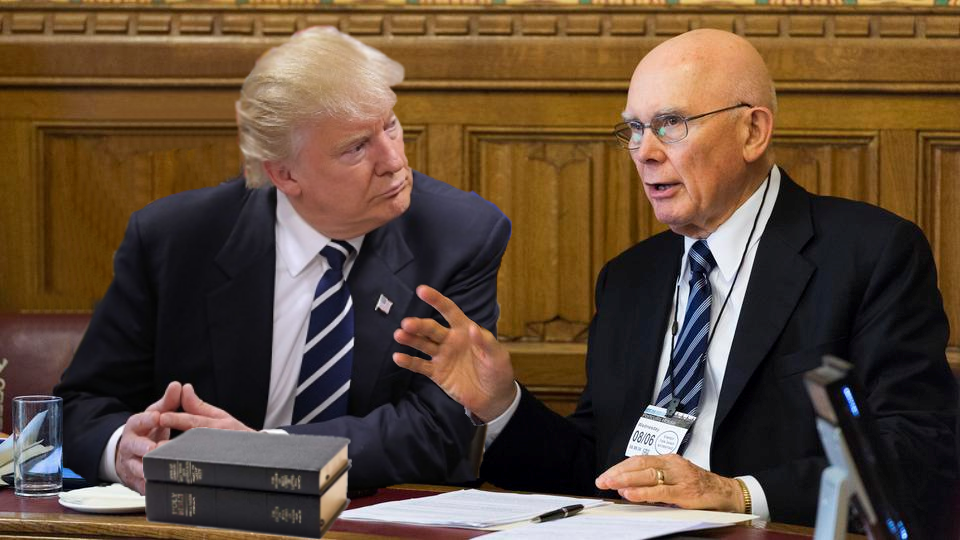Showing all posts by Ziff
An Agenda for President Nelson’s First 40 Days in Office
Day 1: Demote Dieter F. Uchtdorf to regular old member of the Quorum of the Twelve.
Day 2: Talk to the staff at the Ensign and lds.org, and tell them to get the women out of the centerfold in the Conference issues and off the General Authorities page.
Day 3: Get to work editing hymns. In verse 2 of “In Humility, Our Savior,” change the beginning of the second verse from “Fill our hearts with sweet forgiving; Teach us tolerance and love” to “Make our hearts obedient to thee; Teach us who we must not love.”
Day 4: Schedule a tour to promote Sister Nelson’s book The Not Even Once Club.
Day 5: Compose a letter to be read in all sacrament meetings that exhorts members to leave some positive reviews of The Not Even Once Club on Amazon.com.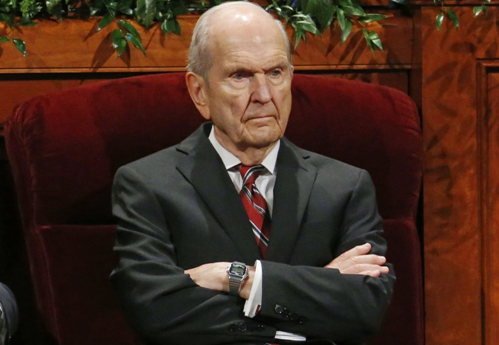
Day 6: Work with Sister Nelson on her manuscript tentatively titled The Don’t Even Think About It Club.
Day 7: Announce a new, improved exclusion policy that bans the children of parents in a gay marriage from entering meetinghouses.
Day 8: Demote Dieter F. Uchtdorf to Seventy.
Day 9: Talk to the facilities management staff about getting those pesky “Visitors Welcome” signs taken down from meetinghouses.
Day 10: Send out a decree that all sacrament meetings must include a reading of the Proclamation on the Family.
Yearly Church President Probabilities for Current Q15 Members
As a supplement to yesterday’s post, I’ve made the graph below that shows the year-to-year probabilities of each Q15 member being President.
The values come from the same mortality table that I used to run the simulation to find the likelihood of each Q15 member ever becoming Church President. This graph doesn’t require any simulation, though. For each Q15 member, I just used his yearly probabilities of survival to come up with yearly cumulative probabilities of survival (i.e., how likely is he to live through this age). Then for each Q15 member, his yearly probability of becoming President is the probability that he survives the year and that all the members senior to him do not. This is found by multiplying probabilities, so for example for Elder Ballard, who is junior only to President Nelson and Elder Oaks, his probability of being President in a particular year is this:
(Ballard cumulative probability of living)*(1 – Nelson probability of living)*(1 – Oaks probability of living)
The results look similar to what we’ve seen in the past with graphs like this, in that there are big probabilities across periods of years for Elders Oaks, Holland, and Bednar. The one big difference is that, as el oso noted yesterday, President Nelson jumped from a pretty low probability for most of his time in the quorum to 100% when President Monson died. I guess this just illustrates that applying a mortality table that gives general trends to a small group of people as I have here is bound to be wrong in big ways at times.
Church President Probability Changes with President Monson’s Death
As you are no doubt aware, President Monson passed away Tuesday evening. As I have before when a member of the Q15 passes away, in this post I’ll show how the probabilities of becoming Church President change for the other members as a result.
All the probabilities come from a simulation I did for a post back in 2015. It’s a straightforward simulation: it uses an actuarial table and each Q15 member’s age and seniority in the quorum as inputs, and it draws a series of random numbers to simulate different possible life expectancies for each member. The life expectancies are then compared to find in what fraction of the simulations each member outlives all other members senior to him to become President. I did 100,000 replications for each run. That is, 100,000 times I drew random numbers for each Q15 member and compared them to his survival probability each year, and then worked out whether each member would become President or not in that scenario, and how many years he would serve if he did. For a more detailed description of the process, see my earlier post.
I realized when writing this post up that I had never done a post to show changes in the probabilities after Elder Hales passed away last October. I’ll start with that. This table shows the changes in probabilities and average number of years serving as President for the other Q15 members after Elder Hales died. Note that all the numbers, including ages, are as of October, 2017.
Nacle Notebook 2017: Funny Comments
This post is my annual compilation of the funniest comments I’ve read on the Bloggernacle in the past year. In case you’ve missed them, here are links to previous years’ posts: 2016 2015 2014 2013 2012 2011 2010 2009 2008. I’m very good with numbers, so I can tell that the fact that there are nine old ones and one new one means that this is my tenth annual post! It seems like this calls for a celebration of some kind, but I’m not sure what form that should take.
Anyway, back to the comments. Most that I’m quoting are excerpts from longer comments or posts. I’ve made each commenter’s name a link back to the original comment or post. The comments are roughly in chronological order.
fbisti, commenting on LDS_Aussie’s post “Lies, Damn lies and Statistics?: Growth and Decline in the LDS Church Membership Numbers” at W&T:
God is fickle (depending on who is the stake president).
Ring Out, Mild Bells!
The Curriculum Department has received a number of complaints that Hymn #215 was promoting wildness among Church members, particularly some of the youth. There have even been reports of unwholesome recreational activities linked to singing of this hymn. We are plea sed to offer this newly revised version, which will replace the existing version when the hymnbook is next revised in 2045.
sed to offer this newly revised version, which will replace the existing version when the hymnbook is next revised in 2045.
Ring out, mild bells, but be restrained,
Keep decibels low, keep echoes brief.
The year is leaving like a thief;
Ring out mild bells, but keep noise contained.
The year is leaving like a thief;
Ring out mild bells, but keep noise contained.
Leaked Memo on the Effects of Non-Priesthood Cooties (NPC)
In the wake of the Church’s recent announcement that young women will be allowed to hand out towels in the temple (and that priest-aged young men will be able to perform and witness baptisms for the dead), the following memo to the First Presidency that preceded the change has been leaked by an unnamed source in the Church hierarchy.
Executive summary
Recent research and revelation indicates that infection with Non-Priesthood Cooties (NPC) would not prohibit young women from handing out towels in the temple, and it is recommended that the current restriction on them doing so be lifted. No other changes in women’s or young women’s participation in priesthood ordinances are recommended, as NPC infection continues to be a serious concern in all other such situations.
Background
As the adornment of humanity, women and girls are, from birth, infected with Non-Priesthood Cooties (NPC) that prevent them from participating in priesthood ordinances in any way. (Note that NPC infection also makes it possible for women to become pornography.) Women’s NPC may even threaten the efficacy and validity of the ordinances themselves if women and girls get too close to them. The threat of NPC extends even to serving as a witness, a fact which has been known to prophets ancient and modern. For example, it is recorded in the New Testament that when the Savior was resurrected, and well-meaning female disciples attempted to convey this information to authorized priesthood leaders, Peter rightly doubted their testimony and believed it only when he had verified the event for himself. Although the women testified truthfully in this case, Peter was doubtless responding to previous situations in which the women’s NPC infection had prevented them from witnessing correctly.
Christmas Classics, Mormonized
Rudolph the Red-Nosed Reindeer
Ostracized by his family and friends because of his freakish red nose, Rudolph the reindeer runs away to the Island of Misfit Toys. While there, he learns about the Unwritten Order of Things and realizes that even though Santa’s secret Reindeer Handbook explicitly says that nose color doesn’t matter when reindeer are chosen to pull his sleigh on Christmas Eve, what this actually means is that nose color conformity is absolutely essential. Armed with this knowledge, Rudolph decides to undergo a painful operation to permanently change the color of his nose. He is welcomed with open hooves when he returns to his family and friends, and he secures a coveted spot on Santa’s reindeer team.
What fraction of missionaries are sisters?
It has been five years since President Monson announced the change in minimum ages at which missionaries can serve. It’s clear that much of the increase in the number of missionaries that followed that announcement came from an increase in how many women were choosing to serve. For example, a 2015 ABC News article on sister missionaries reports (I assume quoting a Church spokesperson) that there were 22,000 sister missionaries at the time, that they made up more than a quarter of all missionaries, and that their numbers had nearly tripled since the age change was announced. Along similar lines, a Deseret News article from one year after the age change reports that there had been increases of 10,000 elders and 11,000 sisters in the previous year. There’s also a Deseret News article from 2014 that gives actual percentage breakdowns: 64% single men, 28% single women, and 8% senior couples.
This increase matches my anecdotal experience. I haven’t tracked anything systematically, but just from following friends on Facebook, it seems like a lot more families who I would have thought were pretty conventionally Mormon have sent daughters on missions in the past few years than did before. I note that they’re conventional because my impression is that having women serve missions before the age change always seemed to me to be a little out of the norm. Like the thinking was that it was a nice thing to do and all, but really shouldn’t women be getting married instead?
It’s great that the news articles I mentioned give some point-in-time snapshots of how many women are serving missions, but what I’m really interested to know is what the trend over time is. For example, I wonder if the number of women serving increased suddenly right after the age change, but then leveled off. Or perhaps it increased at that time, and has continued to increase since then. Or maybe there was a temporary spike and then the number of women serving have decreased.
Like with so many other questions about Church-related data, I’m sure the numbers are available somewhere in the COB, but I’m never going to get to see them. So I did the next best thing and gathered a little data from what I could find. I considered possibilities like counting women and men in missionary alumni Facebook groups, or on a website like LDSMissions.com that allows returned missionaries to register and join a group of others who served in the same mission (although it doesn’t look like the site has been updated in a while). I ended up, though, choosing to gather data from MyMission.com, though, for a couple of reasons. First, it has lists of links to missionary blogs in a nice standard format that was relatively easy to grab. Second, it has missionaries listed as “Sister” or “Elder,” so I didn’t have to make any assumptions about whether someone with a particular first name was female or male.
Book of Mormon people’s names my parents give to me!
In my last post, I looked at how often children in Utah, Idaho, and Arizona are named after the current Church President. I thought it also might be interesting to look at how often children are named after people in the Book of Mormon. One advantage of looking at Book of Mormon names is that it doesn’t require me to limit myself to states with lots of Mormons. If you’re naming your child Nephi, you’re probably Mormon, regardless of where you live. The downside, of course, is that this rules out names that are not unique to the Book of Mormon. For example, someone naming their child Benjamin may be thinking of the Book of Mormon king, but there are many other Benjamins out there that their choice was more likely inspired by.
Because using a Book of Mormon name is a clear marker of Mormonness, there’s even good reason to have a hypothesis beforehand about what the data will look like. In The Angel and the Beehive, Armand Mauss talks about the Church’s shift between the 1960s and 1990s from leaning toward assimilation with the broader world, toward more retrenchment. I think it would make sense to expect that Mormons would use more distinctly Mormon names during a period of retrenchment, when drawing bright lines between the Church and the world is an important practice, than during a period of assimilation. Therefore, I expected to see increasing usage of Book of Mormon names between the 1960s and 1990s.
I got data from the same sources as I did for my last post: the Social Security Administration (SSA) name database for counts of how often names are used by state and year from 1960 to 2014, and CDC Vital Statistics reports for counts of total births by state and year for the same time period. Here is an alphabetical list of the Book of Mormon names I checked:
Abinadi, Abish, Helaman, Jarom, Lehi, Limhi, Mahonri, Mormon, Moroni, Mosiah, Nephi, Omni, Sariah, Teancum, Zeniff
I looked at the girls’ names first: Abish and Sariah. Unfortunately, Abish only shows up in three of the years (1999, 2000, and 2003). The SSA database doesn’t report counts of less than five (for either a state or the entire country), so it’s likely that the name was used in other years, but just fewer than five times. For Sariah, I ran into a different problem. I thought it was a uniquely Book of Mormon name, but while the SSA data shows elevated levels of usage in Utah, Idaho, and Arizona, the name also appears in lots of other states. Overall, Utah, Idaho, and Arizona account for only 11% of uses of the name. I wonder if it isn’t being used by people not referring to the Book of Mormon as an alternative spelling of Saria or another takeoff on Sara(h). In any case, given that the name doesn’t appear to be an indicator of Mormonness, I put it in the non-unique bin with names like Benjamin.
For three of the boys’ names, I found no hits at all: Limhi, Mormon, and Zeniff. Because of the reporting threshold of five, this doesn’t mean these names are never used, but if they are, it’s clearly very rare.
The remainder of my analysis looks at just the remaining ten names. Here’s a graph showing how often they are used in the full US data.
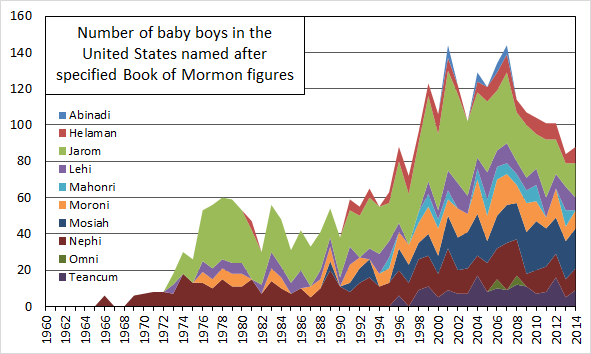 To me, the big surprise here is Jarom. I would never have guessed that it would be used most among the list of names I started with. I included it kind of as an afterthought, since he’s such a minor character.
To me, the big surprise here is Jarom. I would never have guessed that it would be used most among the list of names I started with. I included it kind of as an afterthought, since he’s such a minor character.
Follow the Prophet(‘s Name)
Do Mormons name our kids after the current Church President? I’ve known some people who have (or at least I’m assuming that was their inspiration–Hinckley seems like an unusual name to use for any other reason), but I wondered if it was a more general phenomenon.
Unfortunately, I don’t have Mormon-specific naming data, nor do I have data from outside the US. What I do have is the Social Security name database, which gives yearly counts of names used by state. So I thought it might be interesting to at least look at whether states with lots of Mormons use names of Church Presidents more often than other US states, especially starting around the time a Church President is called. I assembled the name data and the yearly birth count data from the CDC’s Vital Statistics reports as described in this post from last year. As in that post, I got data for the years 1960 through 2014.
I checked the first and last names of all Church Presidents since David O. McKay, although as he became Church President in 1951, I couldn’t check whether there was a change at that time. I compared the percentage of babies given those names in Utah, Idaho, and Arizona, and also the percentage in the rest of the US. The Social Security data reports counts separately for girls and boys, so I checked each name for both. For nearly all the Presidents’ names, I couldn’t see any evidence of the pattern I was looking for. Either the states with lots of Mormons used the name less than the rest of the country, or they hardly used the name at all, or there was no change around the time the President having the name was called.
There are three exceptions, where there is at least a hint that something is going on. All (not surprisingly) are for boys. The names are Spencer (W. Kimball), (Howard W.) Hunter, and Thomas (S. Monson). Here is the graph for Spencer.
A Correlated Excerpt from the Sermon on the Mount
It has come to the attention of the Church Correlation Department that many parts of the Bible have not passed Correlation review prior to being included in the scriptural canon. Rather than go through a lengthy and complex process of decanonization, the Correlation Department has undertaken to simply rewrite the unreviewed parts to smooth off the rough edges. The resulting updated scriptures will preserve the gospel truths present in the original, but will remove the false philosophies of men that have been inserted by evil and conspiring scribes. The resulting version, when completed, will be called the Sacred Holy Inspired Translation.
Today’s updated scripture comes from Matthew 5.
Ye have heard that it was said by them of old time, Thou shalt not commit adultery:
But I say unto you, That whatsoever woman causeth a man to look on her to lust after her by any means hath forced him to commit adultery already with her in his heart. And the blame for this adultery shall be on the woman for not covering herself: the man is blameless.
And if the right shoulder of a woman thou seest causeth thee to lust, cover it up: for it is profitable for thee that thy women should be covered, that thou lust not, that thou should not be cast into hell.
And if the right knee of a woman thou seest causeth thee to lust, cover it up also: for it is profitable for thee that thy women should be covered, that thou lust not, that thou should not be cast into hell.
(Previous entry in this series: The Correlated Story of Zelophehad’s Daughters)
Sacrament Hymns, Ranked (by length)
I have a priest-aged son, and seeing him administer the sacrament has made me pay more attention to the process than I had since I was a priest myself. One issue that I noticed last week was that the sacrament hymn seemed really short, and my son and the other priest hadn’t finished breaking the bread by the time it was over. Of course this isn’t all that unusual. The organist just played through the hymn again while they finished. It was only a matter of a few seconds, but it brought to mind that when I was a priest, I always worried about this happening, because I could feel the pressure of everyone in the congregation waiting for me to just hurry up and finish.
This got me to wondering, though, about how long the sacrament hymns actually are. I looked up the 30 hymns listed under the topic “sacrament” in the back of the hymnbook. (They are all grouped together between hymn numbers 169 and 197, except for #146, “Gently Raise the Sacred Strain.”) I calculated the length of each hymn given its time signature, number of measures and verses, and suggested tempo (I used the midpoint of the lengths implied by taking the fastest and slowest of the suggested tempos.) I included only the verses actually printed in the music because, at least in my experience, it’s typically only those verses that are sung. I didn’t make any adjustment for fermatas.
Here’s the result. It looks like most sacrament hymns are between 1:30 and 3:00 long. A few are shorter. A few are quite a bit longer.
A Thought about Faith-promoting Stories
Every faith-promoting story is also a faith-destroying story. I don’t mean just stories that are passed off as faith promoting but that are more about something else (like over-controlling parents) or stories that turn out to have been embellished. I mean all of them. A faith-promoting story has a conflict to it–someone is stuck in some difficult situation–and that conflict is resolved miraculously. The level of drama involved in the miracle varies a lot, of course. Some miracles are definitely showier than others. Some are quieter, perhaps boiling down to the person realizing that what they thought was a conflict actually wasn’t when they approached it a different way. The reason that faith-promoting stories are also faith-destroying is that for any particular conflict a person faces in such a story, multitudes of other people have faced the same conflict and have not gotten the same miraculous resolution. (It’s the fact that most people don’t get the miracle that makes it a miracle; if it were commonplace, it wouldn’t be miraculous.) This raises the obvious question of why the miracle comes to the one person and not to the others. And there typically isn’t a good answer to this question. God can seem awfully fickle when doling out miracles.
Elder Wickman Warns of “Powerful Coastal Forces”
In an emotional speech, emeritus member of the Seventy Elder Lance B. Wickman repeatedly warned an audience of BYU-I geology students about the dangers of “powerful coastal forces.”
Why steal a sculpture of Joseph Smith and Brigham Young?
Four people stole a sculpture of Joseph Smith and Brigham Young from a Salt Lake business park earlier this week. The sculpture, which depicts the two men sitting together on a bench, has already been recovered, but the thieves’ motive remains unknown.
Here are ten theories for why the thieves might have stolen the sculpture. Please share yours in the comments.
- They were acting on behalf of Jon McNaughton, who had plans to sculpt Donald Trump sitting on the bench next to Joseph and Brigham. Read More
Well, speak of the devil!
In Lynnette’s post a couple of days ago on turning to Christ in the midst of sin, she wrote about how she identified with the struggle to feel worthy to turn to Christ that Martin Luther expressed hundreds of years ago, although, she noted, Luther was more likely to attribute the difficulty of the struggle to the whisperings of Satan, while she as a product of the twentieth century leans more on the language of mental illness. This is a major tangent, but this contrast got me to wondering which GAs today are more or less likely to attribute things to Satan.
Figuring out who’s attributing stuff to Satan is a more difficult task than I really wanted to take on, so I settled for just looking up which GAs talk about Satan the most. Fortunately for me, the LDS General Conference corpus has recently been updated to make it much easier to get results split out by speaker. This even allowed me to broaden my search a little, to include other Conference speakers such as general church officers. I searched the corpus by speaker for uses of “Satan,” as well as three fairly synonymous terms: “devil,” “Lucifer,” and “adversary.” Then I just added up the frequency for each speaker, and converted the results into uses per million words to make them easier to look at. (If you’re interested in differences between how often these terms are used here’s a post I wrote several years ago on that question.)
So who do you think holds the title for referring to Satan most frequently in Conference talks?
You’ll never guess.
Really, you won’t.
Conference Talks Most Likely to Be Edited
Ever since Boyd K. Packer’s October 2010 Conference talk “Cleansing the Inner Vessel” was significantly edited between the version he delivered and the printed version, I’ve seen increased attention paid to differences between the spoken and printed versions of Conference talks.
Given that we’re in the relatively brief window of time between all the Conference talks being given and the release of their printed versions (other than the Women’s Session, for which they’re already out), I thought it might be fun to speculate about what edits we might see this time around. Here are some of my guesses. I’d love to hear yours in the comments.
| Speaker | Spoken version | Printed version (my guess) |
|---|---|---|
| Brough, Saturday morning | “I earnestly prayed to know if I had to give my dog away [after my father was called as a mission president]. My answer did not come in a moment. Rather, a specific thought kept penetrating my mind: Don’t be a burden to your parents.” | “I earnestly prayed to know if I had to give my dog away [after my father was called as a mission president]. My answer came in a flash, as my beloved dog was simultaneously struck by lightning and run over by a train. I rejoiced in the miracle God had provided to keep me from being a burden to my parents.” |
Trump to Resign Presidency to Become Mormon General Authority
In an unprecedented move, US President Donald J. Trump announced today that he will be resigning the Presidency, convert to Mormonism, and become a member of the First Quorum of Seventy, one of the three highest governing bodies in the Salt Lake City-based church. Trump made the announcement in a press conference held on Saturday morning in Salt Lake City, just prior to the second session of the church’s 187th annual conference. In the press conference, Trump was joined by Dallin H. Oaks, a member of the Quorum of the Twelve, the LDS church’s second-highest governing body.
